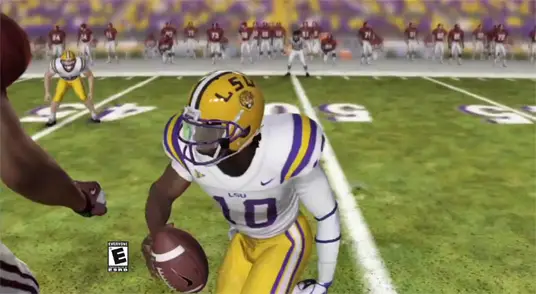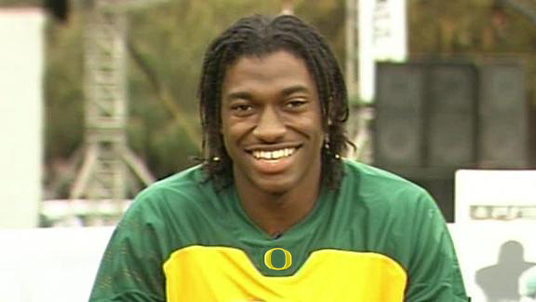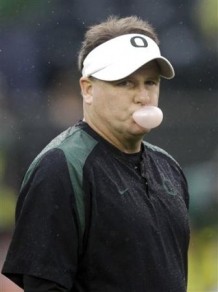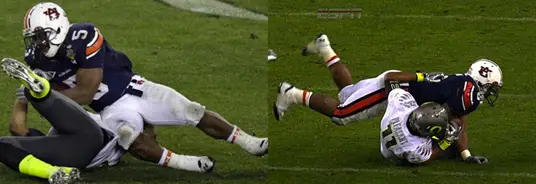 If you are a college football fan who loves video games, today is Christmas Eve. That’s because tomorrow is the release date for NCAA Football 13, EA Sports’ highly celebrated annual college football game. This year’s
If you are a college football fan who loves video games, today is Christmas Eve. That’s because tomorrow is the release date for NCAA Football 13, EA Sports’ highly celebrated annual college football game. This year’s roster update game features an all-new mode called “The Heisman Challenge,” where “fans can build a national powerhouse by placing one of 10 former Heisman Trophy winners on the team of their choice for the upcoming NCAA season.“
Cover man Robert Griffin III is one of a handful of Heisman winners players can choose to insert on the roster of any school. That curiosity is the centerpiece of EA Sports’ ad campaign for this edition; making fans wonder, “What would it be like if Robert Griffin III were a Duck?”
Since the game isn’t available until tomorrow, there is nothing to do but sit around and think about that, and other hypothetical scenarios from Oregon’s recent football history.
There are many what-ifs throughout history, had the ball bounced this way or that catch made, where would the program be today. What if the referees had made the proper call here, or if the weather hadn’t been so bad there or this player hadn’t been injured. It’s easy to speculate, tough to actually change the past (though the NCAA has managed to do that a couple times). Are the Ducks national champions if refs correctly call Michael Dyer’s wrist down, or might that have been Oregon’s third national title if Stanford doesn’t block two punts in the 4th quarter in 2001 and Dennis Dixon doesn’t tear his ACL in 2007? Maybe even if Reuben Droughns doesn’t break his leg in 1998 Oregon is right in the mix for that year’s Pac-10 title. There are many scenarios we could look at, here are just a few…
What if Robert Griffin III had played for Oregon?
Of all these scenarios, this is the most far-fetched to entertain, and it’s not even that difficult to comprehend. Oregon recruited Griffin, and could offer him everything that he enjoyed at Baylor – a spread offense that takes advantage of a quarterback’s speed, an elite track program, green and yellow uniforms, etc – everything except proximity to home. Griffin did mention in the lead up to this year’s NFL draft that Stanford was his second choice (note: possibly apocryphal to make for more interesting draft coverage) so we know that he was at least considering heading out west. If Oregon played for a title while recruiting him in 2007, does Griffin give Oregon a longer look? We’ll say he does, and that longer look is enough to sign him.
Now that Griffin has signed with Oregon, it’s unlikely that Oregon would sign both him and Darron Thomas. Let’s assume that Les Miles clarifies calling Thomas an “athlete” (the initial move that pushed Thomas to Oregon), and Thomas signs with LSU. Replacing Thomas with Griffin synchs up well for discussion purposes – both had freshman years with flashes of brilliance, redshirted in their second year, and became full-time starters their last two seasons.
Griffin started his freshman year at Baylor, and since the quarterback job at Oregon was wide open in 2008, let’s give Griffin the benefit of the doubt and say he wins the job. Given that Oregon’s three losses that season were blowouts (USC, Cal, and yes, Boise State ended close, but it is hard to imagine anyone playing better than Thomas did in that game, so call that a loss), an identical 9-3 record and the Holiday Bowl seems plausible.
In 2009, Griffin tore his ACL in the 3rd game of the season and missed the remainder of the year. Let’s replicate that season in our Oregon scenario, with Oregon bringing in Jeremiah Masoli starting in week 4. That week’s opponent? Cal. Does Masoli still have the same masterful game? Or more importantly, does he have the chemistry with Ed Dickson that allows Dickson to have his equally magical game? Since Masoli’s kryptonite always seemed to be rain, we’ll say yes, and assume that the remainder of Masoli’s Oregon career (success in 2009, then dismissal) plays out identically. Pac-10 champs in 2009 and the first Rose Bowl in 15 years.
Oregon has only lost three games since that 2010 Rose Bowl: Auburn, LSU, and USC in 2011. None of those losses can be blamed directly on Darron Thomas. The LSU loss was driven by fumbles, and it doesn’t matter if Oregon wins or loses that USC game, they are still left out of the BCS title game, so the spoils of 2011 would likely be similar. (Although a Griffin-Thomas season-opening matchup would be terrific.)
That leaves only the Auburn game. With all due respect to Thomas, who was a far better quarterback than people give credit to, Griffin did win the Heisman Trophy. So while Thomas was terrific for his two years, does Griffin give Oregon just enough more to win it all? Thomas did throw for 363 yards in the BCS National Championship, but also early on looked especially out of synch with his decisions in the run game. Does Griffin’s speed spread out Auburn’s defense enough to make a difference and bring Oregon a title? Darron Thomas played terrific in the BCS Championship; he was instrumental in Oregon hanging tough, but if Robert Griffin is in the backfield does that swing the game in Oregon’s favor? He’s just a little too talented to say no. As much as I am happy to clothe the children of Malawi in Oregon National Champions gear, having Robert Griffin would have meant sending those kids some Auburn apparel instead.
What if Nate Costa doesn’t get that extra point snap down against Arizona in 2009?
When Duck fans are asked what schools they hate, there are two almost universal answers: fuskies and beavers. While there is a tortured history with both of those schools, eight and four straight victories respectively in those series has tempered that hatred recently, if only ever so slightly. One Pac-12 school has demonstrated that it’s going to give its best effort to draw as much hatred as possible from Duck fans, whether on the field or in the stands: the Arizona Wildcats.
Take your pick of reasons: the career-ending injuries to Kellen Clemens and Dennis Dixon, the sign that subsequently bragged about those injuries that their fans made for College GameDay in 2009 with a checklist that read “□ Clemens □ Dixon □ Masoli”, the injury of Oregon cheerleader Katelynn Johnson from a water bottle thrown from the crowd during near-riot conditions following Oregon’s double OT victory that resulted in Arizona fans attacking anyone in green and yellow, to the omnipresent anger of former coach Mike Stoops; Arizona has done what it can to be as unseemly as possible in recent seasons.
This is why when Oregon trailed 24-14 early in the fourth quarter of their 2009 game against Arizona, the possibility of missing out on Oregon’s first Rose Bowl in 15 years, and in so doing giving Arizona its first trip to Pasadena ever, was more than fans could stomach. That Oregon team, which would go on to be the first to win the Pac-10 by two games since Washington in 1991, was clearly better than the rest of the league, just needing to get past this late season challenge from the Wildcats. With Arizona students prematurely storming the field, Oregon moved the ball on the Wildcat defense, culminating in a pass from Masoli to Ed Dickson in the end zone with six seconds left, and the Ducks had seemingly tied the game, with nothing left but the formality of the extra point.
The extra point turned out to be anything but a formality. At first glance, while his quick hands made the placement of the kick appear routine, the replay shows it is anything but, an errant snap that left Costa scrambling to get the ball down.
So what happens if Nate Costa doesn’t get the snap down in time? Whether the snap was bobbled or the kick blocked (when watching the replay it is stunning that it wasn’t blocked with two Arizona defenders seemingly on top of the kick), Oregon fails to get the tying point, losing 31-30. The first “for the Rose Bowl” Civil War game doesn’t happen (and the only Civil War of its kind, since the divisional structure prevents the game from having those stakes again), while 9-3 Arizona, who would prevail in the following weeks against Arizona State and USC, would go to the Rose Bowl.
Oregon would likely have played in its second straight Holiday Bowl, and maybe doesn’t find the motivation necessary to get to the National Championship in 2010, making the Rose Bowl the focus instead. While the Ducks surprise early on by starting 10-0, a team whose preseason preparation was on the Rose Bowl and not the National Championship gets surprised at Cal in week 12, but having the tiebreaker with Stanford allows Oregon to still play in the Rose Bowl, their preseason goal.
Don’t think it can happen? That’s exactly what happened this season against USC. With the Pac-12 title all but secured the week before against Stanford, Oregon came out flat and USC found just enough to beat them.
Unprepared for the big stage after playing in its first BCS game in nine years, (remember in this scenario the Ducks missed the Rose Bowl the previous year), Wisconsin finds a way to beat Oregon in similar fashion to how Ohio State did 2010. Now let’s say 2011 plays out the same way, Wisconsin meets Oregon in the Rose Bowl, only now Wisconsin has the upper hand of knowing how to beat the Ducks and uses that advantage to pull off another victory in Pasadena.
Instead of two Rose Bowls (including a win) and a National Championship appearance, the situation instead is two Rose Bowl losses and Oregon is now waiting 96 years for its first Rose Bowl victory, all because of an extra point.
What if Oregon beats Utah in 2003 and Indiana in 2004?
They were both winnable games: a week 6 non-conference match against a Mountain West school, and season opener against a perennial cellar-dweller from a conference (Big Ten) that hadn’t won in Autzen in 26 years.
The Utah team that beat the Ducks was the core of the squad that became the original BCS party-crashers, led by first-year quarterback Alex Smith and first-year coach Urban Meyer. Many players from that Utah team credited that victory, the first over a ranked team in four years, as being the catalyst that kick-started their two year run. If Oregon wins that game, Mike Bellotti might not have cast the spread in such a favorable light.
Conversely, let’s say it now takes Urban Meyer a little longer for his efforts to take root in Salt Lake City, delaying his exodus from Utah by a season. Suddenly, there’s no longer a head coaching vacancy for current Utah coach Kyle Whittingham to fill in 2004, and Meyer never ends up at Florida coaching the Gators to a national title.
Since Whittingham isn’t the head coach at Utah, he can’t hire close friend Andy Ludwig to be his offensive coordinator. Ludwig doesn’t need a job anyway, as he is still the offensive coordinator at Oregon, who despite a disappointing finish, still goes 6-5 after defeating Indiana and plays in a bowl game, the final Silicon Valley Classic; a bowl game which didn’t even have the word “bowl” in its title and took the Pac-10’s sixth place team.
 Without the implementation of the spread, Oregon doesn’t hire Gary Crowton and likely doesn’t enjoy a 10-2 season in 2005. When Oregon has a vacancy for the offensive coordinator position after the 2006 season, if they are still running a pro-style offense, they don’t look for an offensive coordinator specializing in the spread. Bellotti isn’t told by peers to call New Hampshire offensive coordinator Chip Kelly, considered the best spread offensive coordinator available, only to find that Kelly is interested in the job.
Without the implementation of the spread, Oregon doesn’t hire Gary Crowton and likely doesn’t enjoy a 10-2 season in 2005. When Oregon has a vacancy for the offensive coordinator position after the 2006 season, if they are still running a pro-style offense, they don’t look for an offensive coordinator specializing in the spread. Bellotti isn’t told by peers to call New Hampshire offensive coordinator Chip Kelly, considered the best spread offensive coordinator available, only to find that Kelly is interested in the job.
Kelly never comes to Oregon and never becomes the eventual head coach two years later. His absence means there are possibly up to three fewer Pac-12 trophies in the display case at the Casanova Center. Maybe the spread offense still makes its way to Eugene the way it has at so many other schools, but it wouldn’t be the Chip Kelly version we have come to know and love.
That is how alternate histories go. These are just a handful of the possible repercussions should one little bounce, one slight change in fortune occurs—some good, some bad. One can lament that things could have been better, or celebrate that things could have been worse. But they’re nothing more than that, arguments, best left for bar conversation and video games.
For many college football fans, the allure of NCAA Football 13 lies in its ability to rectify its school’s own tortured history, to create a more palatable college football universe for the user. But Duck fans don’t need a video game to create an alternate history for their frustrations; the original history seems to have worked out just fine recently. Though if Michael Dyer’s wrist is called down in the national championship…

NCAA Rulebook Article 3 section b. A live ball becomes dead and an official shall sound his whistle or declare it dead: When any part of the ball carrier's body, except his hand or foot, touches the ground or when the ball carrier is tackled or otherwise falls and loses possession of the ball as he contacts the ground with any part of his body, except his hand or foot.
Related Articles:
Chip Kelly Update: Everything's Good Again ...
Chip Kelly Update: Wailing and Gnashing of Teeth
Shock and Awe -- The Oregon Ducks' Football Hangover Effect
Despite Lopsided Score, Georgia State "Never Stopped Believing"
Hope Springs Eternal for Ducks
Incompetent Pac-12 Officials: How Do You Miss ALL of THIS?
Nathan Roholt is a senior writer and managing editor emeritus for FishDuck. Follow him on Twitter @nathanroholt. Send questions/feedback/hatemail to nroholtfd@gmail.com.

